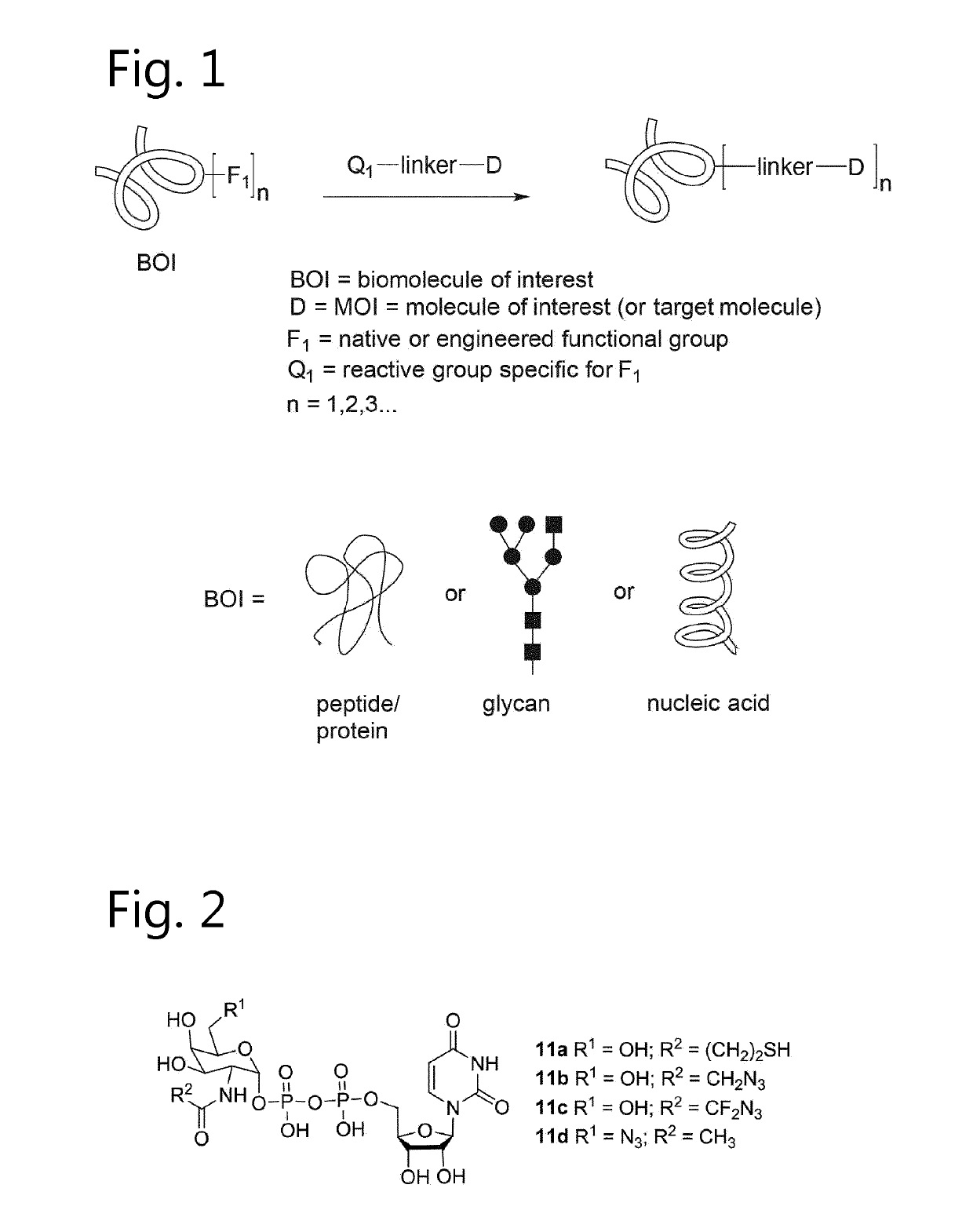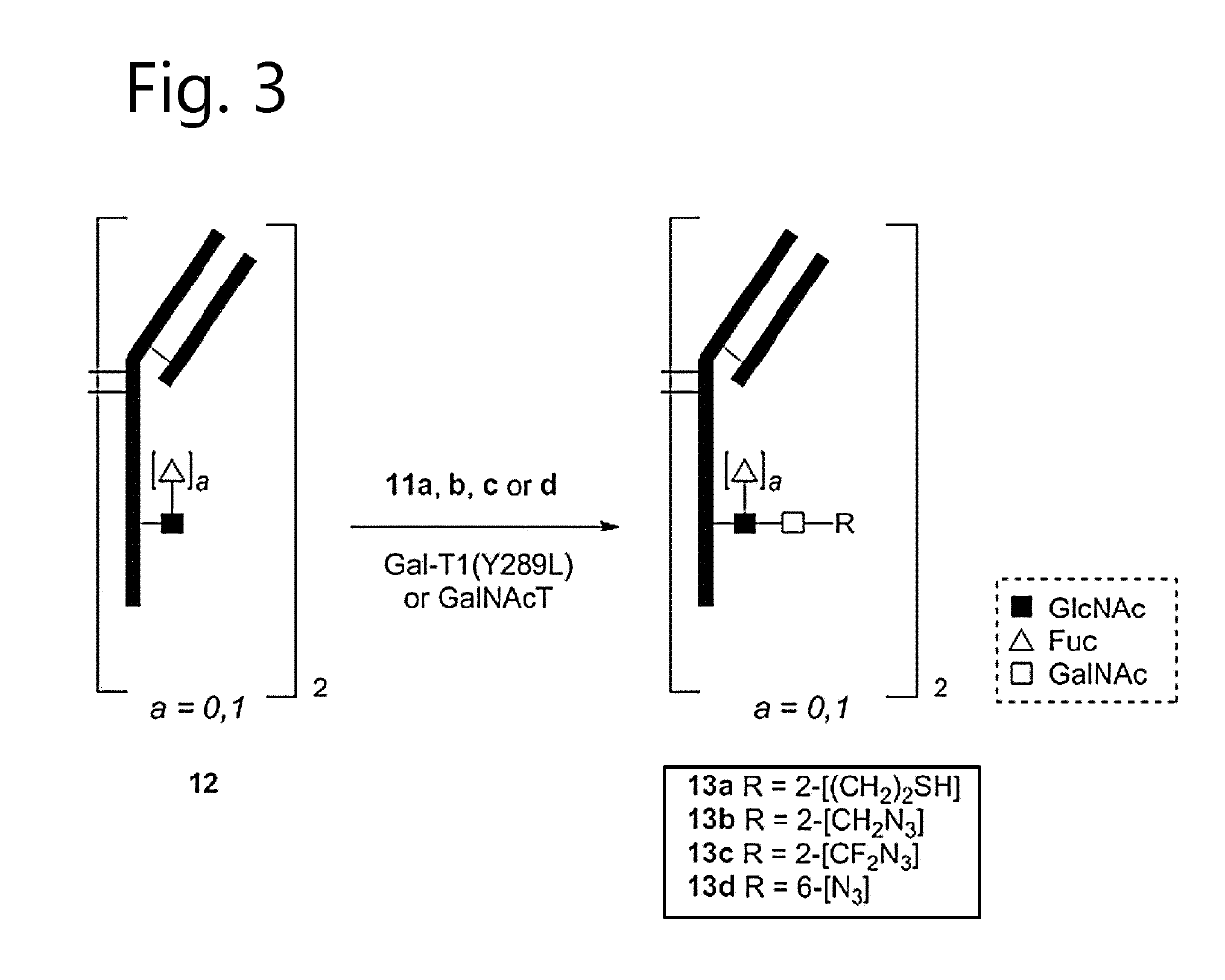Antibody-conjugates with improved therapeutic index for targeting cd30 tumours and method for improving therapeutic index of antibody-conjugates
a technology of antibody conjugates and tumours, applied in the field of bioconjugation, can solve the problems of limiting the choice of reactive groups, compromising conjugation efficiency, and high restrictions on biomolecules, and achieve the effect of increasing the therapeutic index of a bioconjugate and a greater therapeutic index
- Summary
- Abstract
- Description
- Claims
- Application Information
AI Technical Summary
Benefits of technology
Problems solved by technology
Method used
Image
Examples
example 1
Expression and Purification of cAC10
[0556]cAC10 was transiently expressed in CHO K1 cells by Evitria (Zurich, Switzerland) at 5 L scale. The supernatant was purified using a XK 26 / 20 column packed with 50 mL protein A sepharose. In a single run 5 L supernatant was loaded onto the column followed by washing with at least 10 column volumes of 25 mM Tris pH 7.5, 150 mM NaCl. Retained protein was eluted with 0.1 M Glycine pH 2.7. The eluted cAC10 was immediately neutralized with 1.5 M Tris-HCl pH 8.8 and dialyzed against 25 mM Tris pH 8.0. Next the IgG was concentrated to approximately 20 mg / mL using a Vivaspin Turbo 15 ultrafiltration unit (Sartorius) and stored at −80° C. prior to further use.
example 2
Expression and Purification of Iratumumab
[0557]Iratumumab was transiently expressed in CHO K1 cells by Evitria (Zurich, Switzerland) at 125 mL scale. The supernatant was purified using a HiTrap mAbSelect SuRe 5 mL column (GE Healthcare). The supernatant was loaded onto the column followed by washing with at least 10 column volumes of 25 mM Tris pH 7.5, 150 mM NaCl. Retained protein was eluted with 0.1 M Glycine pH 2.7. The eluted product was immediately neutralized with 1.5 M Tris-HCl pH 8.8 and dialyzed against 20 mM Tris pH 7.5. Next the product was concentrated to 14.4 mg / mL using a Vivaspin Turbo 15 ultrafiltration unit (Sartorius) and stored at −80° C. prior to further use.
example 3
Expression and Purification of his-TnGalNAcT(33-421
[0558]His-TnGalNAcT(33-421) (identified by SEQ ID NO: 2) was transiently expressed in CHO K1 cells by Evitria (Zurich, Switzerland) at 5 L scale. The supernatant was purified using a XK 16 / 20 column packed with 25 mL Ni sepharose excel (GE Healthcare). Each run approximately 1.5 L supernatant was loaded onto the column followed by washing with at least 10 column volumes of buffer A (20 mM Tris buffer, 5 mM imidazole, 500 mM NaCl, pH 7.5). Retained protein was eluted with buffer B (20 mM Tris, 500 mM NaCl, 500 mM imidazole, pH 7.5). The buffer of the eluted fractions was exchanged to 25 mM Tris pH 8.0 using a HiPrep H26 / 10 desalting column (GE Healthcare). The purified protein was concentrated to at least 3 mg / mL using a Vivaspin Turbo 4 ultrafiltration unit (Sartorius) and stored at −80° C. prior to further use.
Sequence of His-TnGalNAcT(33-421) (SEQ. ID NO: 2): 1HHHHHHSPLR TYLYTPLYNA TQPTLRNVER LAANWPKKIP SNYIEDSEEY 51SIKNISLSNH TT...
PUM
| Property | Measurement | Unit |
|---|---|---|
| weight distribution | aaaaa | aaaaa |
| weight distribution | aaaaa | aaaaa |
| weight distribution | aaaaa | aaaaa |
Abstract
Description
Claims
Application Information
 Login to View More
Login to View More - R&D
- Intellectual Property
- Life Sciences
- Materials
- Tech Scout
- Unparalleled Data Quality
- Higher Quality Content
- 60% Fewer Hallucinations
Browse by: Latest US Patents, China's latest patents, Technical Efficacy Thesaurus, Application Domain, Technology Topic, Popular Technical Reports.
© 2025 PatSnap. All rights reserved.Legal|Privacy policy|Modern Slavery Act Transparency Statement|Sitemap|About US| Contact US: help@patsnap.com



